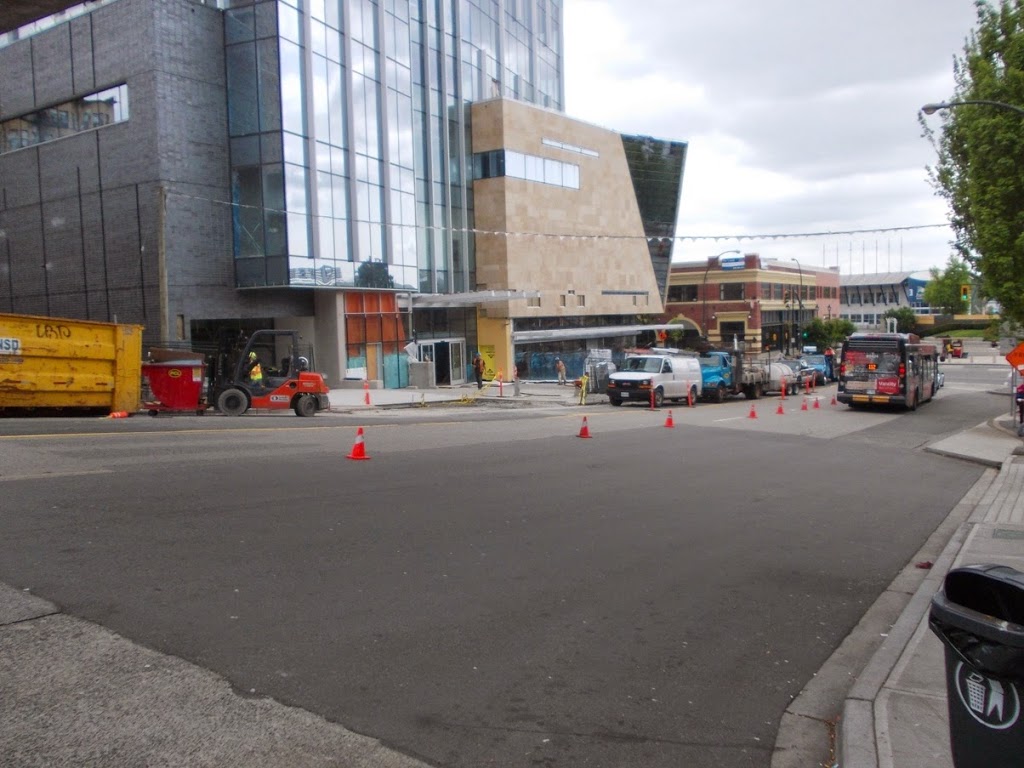Let’s skip the obligatory apologies for infrequent updates here; I’m busy.
On a not-unrelated note, I was on my way to the very successful RCFM fundraiser on Wednesday night when I noted that we are soon to get our sidewalk back, as the Anvil Centre nears completion.
This is great news, as the deplorable condition around the east entrance of New Westminster station and lack of connection with the rest of Columbia Street has been disruptive for a couple of years. I look forward to the opening of the Anvil, the re-activation of that important piece of real estate as a new, expanded public space. I also look forward to a return to the debate about the need for a mid-block crosswalk at the foot of 8th Street between Carnarvon and Columbia.
We have been through this debate at least twice before, once when the crosswalk was installed, and once again when it was removed a few years later. The removal was put off until the start of Anvil construction, when the sidewalk on the east side of 8th essentially ceased to exist. Now that there will be a major destination on the other side of 8th, the obvious, direct, and dry route for pedestrians connecting between Anvil and Plaza 88 will once again be up for discussion.
Much like the recent discussion about a mid-block crosswalk on Eighth Avenue by the Massey Theatre, to make safer the preferred pedestrian route between major destinations, the idea of a mid-block crossing at the foot of 8th Ave is a measure of how serious the City is about its Pedestrian Charter.
Then on Thursday night I was on my way to the NWEP meeting in Uptown, and I notice this sparkling new piece of bicycle infrastructure on Seventh Avenue, built concurrent with the redevelopment of the new drugstore at the corner with of 6th Street:
Bike lanes are important here, because Seventh is part of the Rotary Crosstown Greenway, one of the City’s primary bike routes, connecting the West End to Uptown to Glenbrook and upper Sapperton. As far as east-west travel across the upper part of the City, it is the premier bike route, as important as the Central Valley Greenway (the connections of which I was recently lamenting).
With that context, just look at this ridiculous piece of infrastructure:
A cyclist is meant to clear the signal-controlled intersection at 6th, take a sharp right turn into the dip at the curb then up onto a sidewalk, clear the pedestrians, then take another hard left before hitting the light standard to dump themselves back into traffic immediately in front of a parked car just before two (2!) driveways where the opulent 30m of bike lane abruptly stops.
Allow me to count the many ways this installation fails. The entry point creates confusion for three modes (cyclist, turning car, pedestrians), all of whom are forced to cross each other at the single crosswalk point. The cyclist is forced to share the crosswalk with pedestrians, who are unlikely to be expecting them there when they get out of the passenger side of their car, when they go to the parking meter, or when they are simply walking on the sidewalk as pictured below. The exit back onto the street is again confusing for the cyclist and the drivers who may be either passing a line of parked cars when a bike appears, or even turning right into the driveways (see picture below) when a cyclist appears “out of nowhere” from the behind the parked cars, and hops off the sidewalk. I honestly have no idea who has right of way in that collision!
For drivers pulling out of the driveways, the pole is located perfectly to block the driver’s vision, requiring them to pull a little forward, and making it more likely they will pull right in front of a cyclist who is checking his left shoulder as he is about to hop back into traffic (note this picture has no-one in the parking spots – so this is optimum visibility).
Now I can sort of see what the thinking is – it is a Greenway, we need to accommodate bikes. The developer will pay for sidewalk improvements, so let’s get it done by him. Businesses need parking, so let’s protect the 3 precious spots. With all these best intentions, the result is actually significantly worse than if they had done nothing at all. By trying to build a “bike path” where it doesn’t work, and not connecting it meaningfully to anything, they have made the situation considerably less safe for pedestrians and cyclists.
I’m not sure if I am more angry about the danger created, or the money wasted doing it!
I look at this fiasco and I wonder why? How? What was everyone thinking? Surely at some point someone – the person creating the drawing, the person approving the drawing, the person laying the concrete, the person painting the white lines – looked and said: what are we doing here? Does this make any sense at all?
We can do better. We need to do better.





I will continue straight through the intersection as I always have. Whatever they’ve done, it makes no sense at all, at least not for bikes.